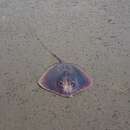pt-BR
nomes no trilho de navegação


Hemitrygon bennettii ist eine Stechrochenart und lebt im Indopazifik zwischen Indien und Japan. Einzelne Sichtungen werden auch aus Vanuatu und Neukaledonien berichtet.
Hemitrygon bennettii erreicht eine Gesamtlänge von maximal 1,30 Meter. Er hat eine rautenförmige Brustflossen-Scheibe von etwa gleicher Länge und Breite, die 50 cm erreichen kann. Die vorderen Säume der Scheibe sind gerade und enden in einer dreieckigen Schnauze, die hinteren Säume sind zum Schwanz hin abgerundet. Der Schwanz ist peitschenartig, bis zu dreimal so lang wie die Scheibe und trägt einen Stachel. Die Oberseite ist gelb-braun und wird im Bereich des Schwanzes dunkler, die Unterseite ist hell.
Der Rochen lebt küstennah am Meeresboden, zum Teil auch im mündungsnahen Süßwasser von Flüssen. Er jagt kleinere Fische und ist ovovivipar. Über seine Lebensweise ist allgemein sehr wenig bekannt.
Die Rochenart wurde im Jahr 1841 durch die deutschen Naturwissenschaftler Johannes Müller und Jakob Henle unter der wissenschaftlichen Bezeichnung Trygon bennettii beschrieben, später dann der Gattung Dasyatis zugeordnet. Bei einer Mitte 2016 erfolgten Revision der Dasyatidae wurde die Art in die Gattung Hemitrygon gestellt.[1]
Hemitrygon bennettii ist eine Stechrochenart und lebt im Indopazifik zwischen Indien und Japan. Einzelne Sichtungen werden auch aus Vanuatu und Neukaledonien berichtet.
The Bennett's stingray or frilltailed stingray (Hemitrygon bennetti, often misspelled benetti or bennettii)[2] is a little-known species of stingray in the family Dasyatidae, with a wide but ill-defined distribution in the Indian and Pacific Oceans. This species is characterized by a rhomboid, yellow-brown pectoral fin disc with a fairly long snout, and an extremely long tail with a correspondingly long ventral fin fold. It measures up to 50 cm (20 in) across. It feeds on fish, and is aplacental viviparous. It is likely caught by demersal fisheries.
The fish is possibly named in honor of zoologist Edward Turner Bennett (1797-1836),[3]
German biologists Johannes Peter Müller and Friedrich Gustav Jakob Henle described the Bennett's stingray as Trygon bennettii in their 1839–1841 Systematische Beschreibung der Plagiostomen. They referenced three specimens as the species syntypes: only the one from China remains, while another from Trinidad and a third of unknown provenance have been lost. Later authors synonymized the genus Trygon with Dasyatis.
The range of the Bennett's stingray is somewhat uncertain due to confusion with other species. It is a bottom-dweller that occurs in the coastal waters of the Indo-Pacific region, from India, through Indochina, to southern China, Japan, and perhaps the Philippines; it seems to be most common in the northwestern Pacific. This species has also been reported from Vanuatu and New Caledonia; the single historical record from Trinidad may be a misidentification.[1][2] It has been known to enter fresh water, including the Perak River in peninsular Malaysia and the Indragiri River in Sumatra.[4]
The Bennett's stingray has a diamond-shaped pectoral fin disc almost as wide as long, with straight leading margins converging on a triangular, moderately protruding snout. The trailing margins of the disc are convex. There are 31 upper and 33 lower tooth rows, and 3 or 5 papillae across the floor of the mouth. The tail is whip-like and can measure three times the length of the disc, proportionately longer than any other North Pacific Dasyatis species.[5] There is a stinging spine on the upper surface of the tail, and a fin fold underneath measuring 60–67% the disc width. Young individuals have small dermal denticles in the middle of the back, whereas adults have a row of tubercles along the midline of the back and tiny thorns covering the tail. The coloration is yellowish brown above, becoming darker on the tail fold, and light below.[5] This species attains a disc width of 50 cm (20 in) and a total length of 1.3 m (4.3 ft).[1]
There is little information on the natural history of the Bennett's stingray.[1] It preys on fish, and is aplacental viviparous like other stingrays.[2]
The Bennett's stingray is susceptible to bottom trawl and net gear and probably caught by fisheries within its range, which include intensive, targeted ray fisheries off Thailand, Singapore, India, and elsewhere. The International Union for Conservation of Nature (IUCN) has listed this species as vulnerable.[1]
{{cite journal}}: CS1 maint: multiple names: authors list (link) The Bennett's stingray or frilltailed stingray (Hemitrygon bennetti, often misspelled benetti or bennettii) is a little-known species of stingray in the family Dasyatidae, with a wide but ill-defined distribution in the Indian and Pacific Oceans. This species is characterized by a rhomboid, yellow-brown pectoral fin disc with a fairly long snout, and an extremely long tail with a correspondingly long ventral fin fold. It measures up to 50 cm (20 in) across. It feeds on fish, and is aplacental viviparous. It is likely caught by demersal fisheries.
Hemitrygon bennettii es una especie de pez de la familia Dasyatidae en el orden de los Rajiformes.
Los machos pueden llegar alcanzar los 50 cm de longitud total.[2][3]
Es ovíparo.
Come peces hueso.
Es un pez de mar y de clima tropical y demersal.
Se encuentra en la China (incluyendo Hong Kong), la India, el Irán, el Japón, Nueva Caledonia, las Filipinas, Sri Lanka, Taiwán, Vanuatu y el Vietnam.
Es inofensivo para los humanos.
Hemitrygon bennettii es una especie de pez de la familia Dasyatidae en el orden de los Rajiformes.
Dasyatis bennettii Dasyatis generoko animalia da. Arrainen barruko Dasyatidae familian sailkatzen da.
Dasyatis bennettii Dasyatis generoko animalia da. Arrainen barruko Dasyatidae familian sailkatzen da.
Dasyatis bennettii est une espèce de raies appartenant à la famille des Dasyatidés